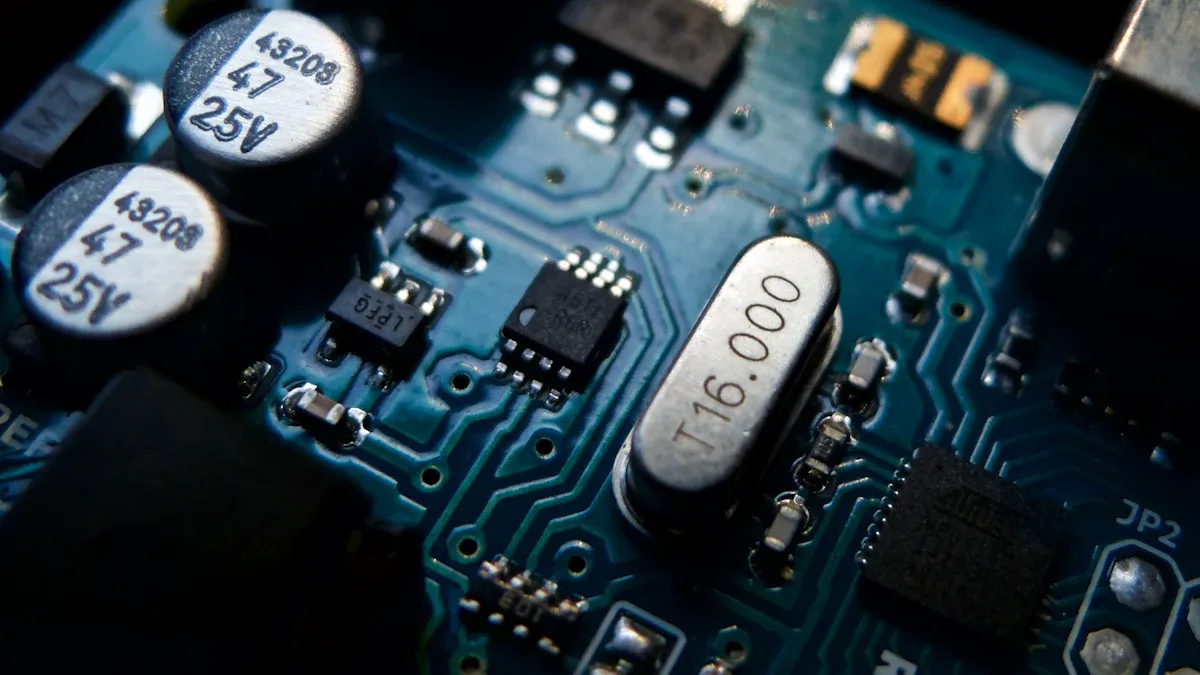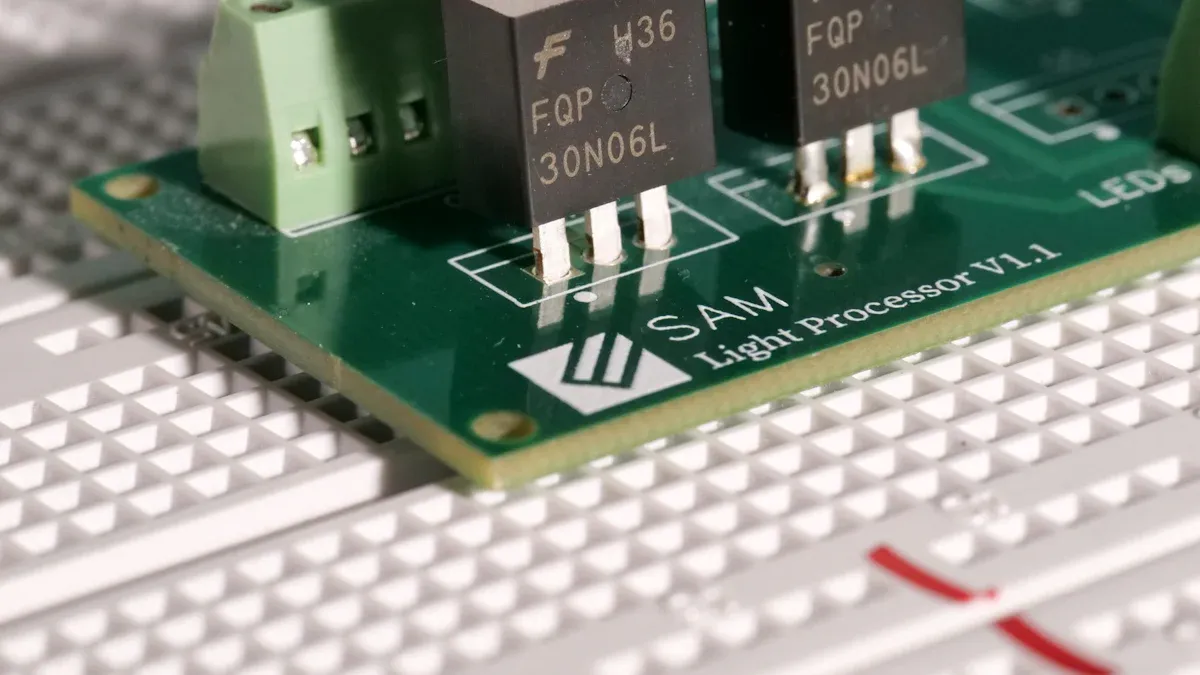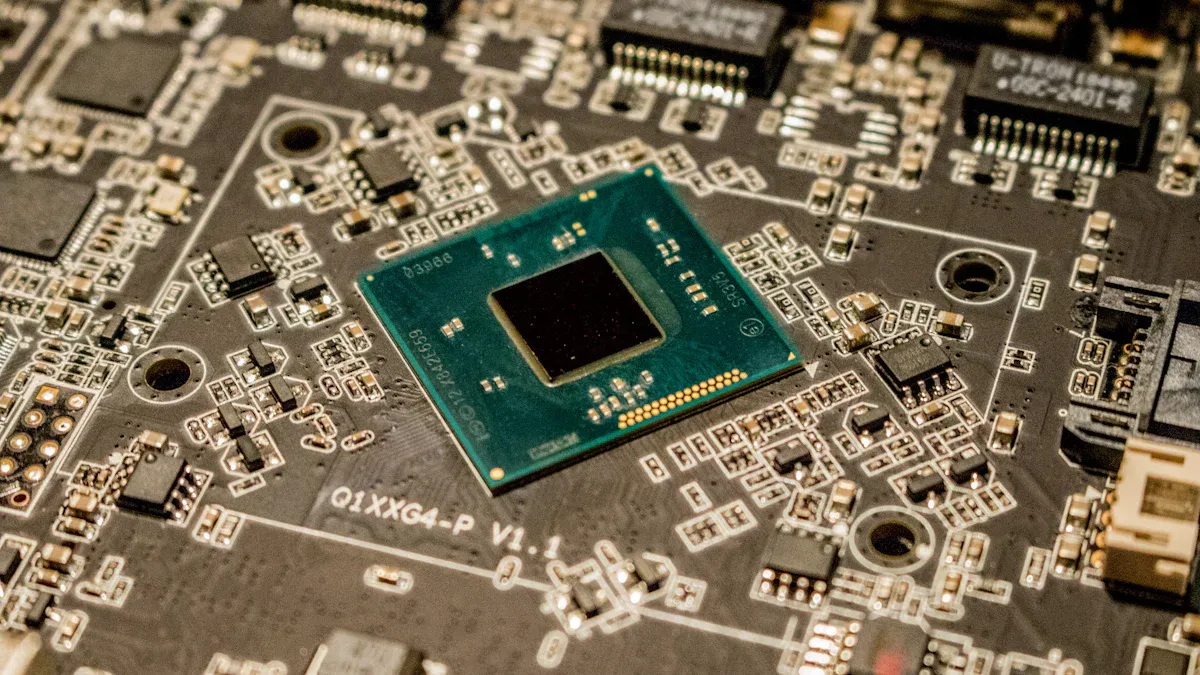What is a Low Impedance Switch Chip?

A low impedance switch chip is a specialized electronic component that reduces resistance in the signal path. By minimizing resistance, it ensures signals flow smoothly and efficiently. This chip plays a key role in maintaining the quality and integrity of signals, especially in high-performance circuits. You’ll find it valuable in applications where reliable and efficient signal transmission is critical, such as audio systems and power management solutions. Its design focuses on optimizing signal flow, which helps improve overall circuit performance and reliability.
Key Takeaways
Low impedance switch chips lower resistance, helping signals move easily.
Knowing about impedance is key to making good electronic systems.
It keeps signals strong and stops data from being lost.
These chips work well in fast systems by reducing signal bumps.
They give steady current paths, making devices more reliable.
Low impedance switch chips are used in gadgets and cars.
They help keep signals clear and manage power better.
New tech like CMOS and materials like silicon carbide improve them.
This makes them work well even in tough conditions.
Understanding Impedance and Its Importance
What is Impedance in Electronics?
Impedance is a measure of how much a circuit resists the flow of alternating current (AC). It combines resistance, inductance, and capacitance into a single value, expressed in ohms (Ω). Unlike simple resistance, impedance changes with frequency, making it a critical factor in AC circuits. You can think of it as the "traffic control" for electrical signals, determining how easily they pass through a circuit.
In electronics, understanding impedance is essential for designing efficient systems. For example, high impedance can distort signals, while mismatched impedance between components can cause signal reflections. These reflections lead to data loss and reduced performance. The table below highlights the importance of managing impedance in electronic design:
Aspect | Importance | Impact on Performance |
|---|---|---|
Signal Integrity | Ensures clear signals in high-speed circuits. | Reduces errors in data transmission. |
Signal Reflections | Prevents signals from bouncing back, which can cause data loss. | Enhances reliability of communication. |
Crosstalk | Minimizes interference between signals, leading to clearer data. | Improves overall system performance. |
EMI (Electromagnetic Interference) | Reduces noise, leading to better signal clarity. | Increases efficiency in critical systems. |
Longevity of PCB | Strengthens the PCB, leading to longer lifespan and reduced repair costs. | Cost-effective in the long run. |
Why Low Impedance is Crucial for Switch Chips
A Low Impedance Switch Chip plays a vital role in ensuring smooth signal flow. Low impedance reduces resistance in the circuit, which minimizes signal ripple and enhances performance in high-speed applications. For instance, in printed circuit boards (PCBs), low impedance in power rails prevents disruptions caused by gaps in power planes. This stability ensures that return currents flow efficiently, maintaining signal integrity.
Here are some key reasons why low impedance is essential for switch chips:
It prevents excessive signal ripple, which can degrade the performance of high-speed circuits.
It provides stable return paths for current, reducing disruptions in the circuit.
It allows return currents to navigate across gaps in power planes effectively, ensuring reliable operation.
By maintaining low impedance, you can achieve better signal clarity, improved reliability, and enhanced overall performance. This makes the Low Impedance Switch Chip a critical component in modern electronics.
How a Low Impedance Switch Chip Works

Internal Mechanisms of Low Impedance Switch Chips
A Low Impedance Switch Chip operates by minimizing resistance in the signal path. Inside the chip, specialized circuits manage the flow of electrical signals. These circuits ensure that signals pass through with minimal loss or distortion. The chip achieves this by using materials and designs that reduce resistance and improve conductivity.
One way to understand the internal workings is through laboratory tests like impedance spectroscopy. For example, studies on malaria-infected red blood cells have shown how impedance spectroscopy can detect changes in cell membrane properties. Similarly, this method can validate the behavior of low impedance circuits. It helps engineers analyze how the chip performs under different conditions, ensuring its efficiency and reliability.
Simulations also play a key role in understanding the chip's internal mechanisms. SPICE simulations, for instance, allow engineers to model the chip's performance in a power distribution network (PDN). These simulations provide data on impedance characteristics and transient responses. By analyzing this data, engineers can fine-tune the chip's design to optimize its performance.
Design Principles and Technologies (e.g., CMOS)
The design of a Low Impedance Switch Chip relies on advanced principles and technologies. One common technology used is CMOS (Complementary Metal-Oxide-Semiconductor). CMOS technology is popular because it consumes less power and offers high efficiency. It uses a combination of p-type and n-type transistors to control the flow of current. This design reduces power loss and ensures stable operation.
Engineers also focus on minimizing parasitic elements in the chip's design. Parasitic elements, such as stray capacitance and inductance, can increase impedance and degrade performance. By carefully designing the layout and using high-quality materials, engineers can reduce these unwanted effects.
SPICE simulations further enhance the design process. These simulations help engineers model low-speed digital components and extract network parameters. For example, they can analyze the PDN impedance spectrum to identify potential issues. This approach ensures that the chip performs well even under challenging conditions, such as high-capacitance loads.
Benefits of Low Impedance Switch Chips
Enhanced Signal Efficiency
A low impedance switch chip significantly improves signal efficiency by reducing resistance in the circuit. This allows electrical signals to travel with minimal loss, ensuring better performance in high-speed applications. When compared to traditional designs, these chips excel in key performance indices.
Performance Index | Wirewound Ferrite Beads | Traditional Chip Ferrite Beads |
|---|---|---|
Attenuation | High | Limited |
Frequency Performance | Wide | Limited |
DC Resistance (DCR) | Lower | Higher |
Current Ratings | Higher | Lower |
As shown in the table, low impedance designs outperform traditional ones in areas like attenuation and frequency performance. This makes them ideal for applications where signal clarity and efficiency are critical. By using these chips, you can ensure that your circuits operate at peak efficiency, even in demanding environments.
Improved Performance in High-Capacitance Loads
High-capacitance loads often challenge traditional circuits, leading to slower response times and reduced efficiency. A low impedance switch chip addresses this issue by providing a stable and efficient path for current flow. This stability ensures that the chip can handle large capacitance without compromising performance.
For example, in power distribution networks, these chips maintain consistent voltage levels, even under heavy loads. This prevents voltage drops and ensures that connected devices receive a steady supply of power. By incorporating low impedance switch chips into your designs, you can achieve faster response times and improved reliability, even in circuits with high-capacitance components.
Greater Reliability and Noise Immunity
Reliability and noise immunity are critical in modern electronics, especially in environments with high electromagnetic interference (EMI). Low impedance switch chips excel in these areas by leveraging advanced design principles. Differential logic families, such as low-voltage differential signaling (LVDS), use the difference between two voltage levels instead of referencing ground. This approach enhances noise immunity and reduces susceptibility to common-mode noise.
Additionally, emitter-coupled logic (ECL) circuits, which operate at high speeds, benefit from differential transmission. These features make low impedance switch chips more reliable and less prone to noise-related issues. By using these chips, you can ensure that your circuits remain stable and efficient, even in challenging conditions.
Applications of Low Impedance Switch Chips

Consumer Electronics and Audio Systems
You encounter low impedance switch chips in many consumer electronics and audio systems. These chips enhance signal clarity and efficiency, making them ideal for devices like smartphones, headphones, and home theater systems. By reducing resistance, they ensure audio signals remain crisp and free from distortion.
In audio systems, low impedance switch chips support technologies like low-voltage differential signaling (LVDS). LVDS minimizes power consumption while maintaining high data rates, which is crucial for delivering high-quality sound. The table below highlights key performance metrics that demonstrate the advantages of these chips in consumer electronics:
Feature | Value |
|---|---|
Signal Amplitude | ~350 mV |
Power Consumption (LVDS) | |
Constant Current Source | 3.5 mA |
Theoretical Limit Rate | 1.923 Gbps |
Data Rate | Several thousand Mbps |
These features make low impedance switch chips indispensable for modern audio systems, ensuring you enjoy immersive sound experiences without compromising efficiency.
Automotive and Power Systems
In automotive and power systems, low impedance switch chips play a critical role in managing electrical loads and ensuring reliable operation. They help stabilize voltage levels in circuits, which is essential for powering sensitive components like sensors and microcontrollers.
You’ll find these chips in electric vehicles (EVs), where they optimize power distribution and improve battery efficiency. By reducing resistance, they prevent energy loss and ensure consistent performance across various subsystems. This makes them vital for maintaining the reliability of automotive electronics, especially in high-demand environments.
Industrial and High-Power Applications
Industrial and high-power applications demand components that can handle extreme conditions. Low impedance switch chips meet these requirements by offering high reliability and efficiency. They are used in power distribution networks, motor drives, and renewable energy systems.
Several advancements in semiconductor technology, such as silicon carbide (SiC) and gallium nitride (GaN), enhance the performance of these chips. These materials enable higher power densities and lower on-state resistance, making them ideal for high-power circuits.
High cutoff frequencies and low on-state resistance improve power handling densities.
Soft-switching methodologies reduce performance degradation by monitoring changes in Drain Source ON Resistance (RDS-ON) over time.
Rigorous reliability testing ensures these chips can withstand environmental stresses and maintain consistent performance. By incorporating low impedance switch chips into industrial systems, you achieve greater efficiency and longevity, even under demanding conditions.
Low Impedance Switch Chips simplify signal transmission by reducing resistance in circuits. You can rely on them to improve signal clarity, enhance efficiency, and ensure reliable operation in demanding applications. These chips play a vital role in modern electronics, from consumer devices to industrial systems. By integrating them into your designs, you optimize circuit performance and extend the lifespan of your devices.
Low Impedance Switch Chips are essential for achieving high-quality signal flow and maintaining system reliability. Their impact on electronics continues to grow as technology advances.
FAQ
What makes a low impedance switch chip different from a regular switch chip?
A low impedance switch chip minimizes resistance in the signal path. This ensures efficient signal transmission and reduces power loss. Regular switch chips may not prioritize low resistance, which can lead to signal degradation and inefficiency in high-performance applications.
Can low impedance switch chips improve audio quality?
Yes, they can. These chips reduce resistance, which helps maintain signal clarity and prevents distortion. In audio systems, this ensures crisp and high-quality sound, making them ideal for devices like headphones and home theater systems.
Are low impedance switch chips suitable for high-power applications?
Absolutely. These chips handle high-power loads efficiently by reducing resistance and improving conductivity. They are commonly used in industrial systems, motor drives, and renewable energy applications where reliability and performance are critical.
How do low impedance switch chips enhance reliability?
They enhance reliability by reducing noise and electromagnetic interference (EMI). Advanced designs, like differential signaling, improve noise immunity. This ensures stable operation even in environments with high EMI, making your circuits more dependable.
What technologies are used in low impedance switch chips?
Most low impedance switch chips use CMOS technology. CMOS combines low power consumption with high efficiency. Advanced materials like silicon carbide (SiC) and gallium nitride (GaN) further improve performance in high-power and high-frequency applications.
See Also
Exploring Low Energy IoT Chip Innovations And Their Uses
A Guide To Control Chips In Smart Home Devices
An Overview Of Communication Chips And Their Functionality
